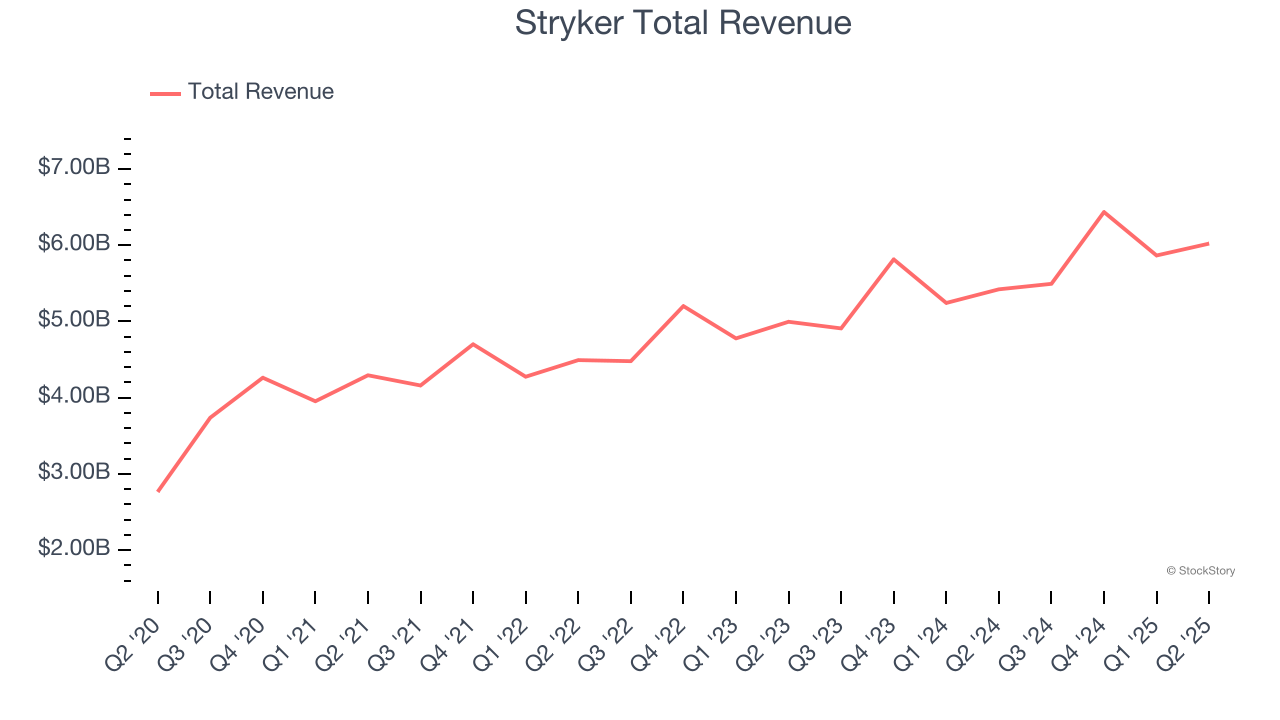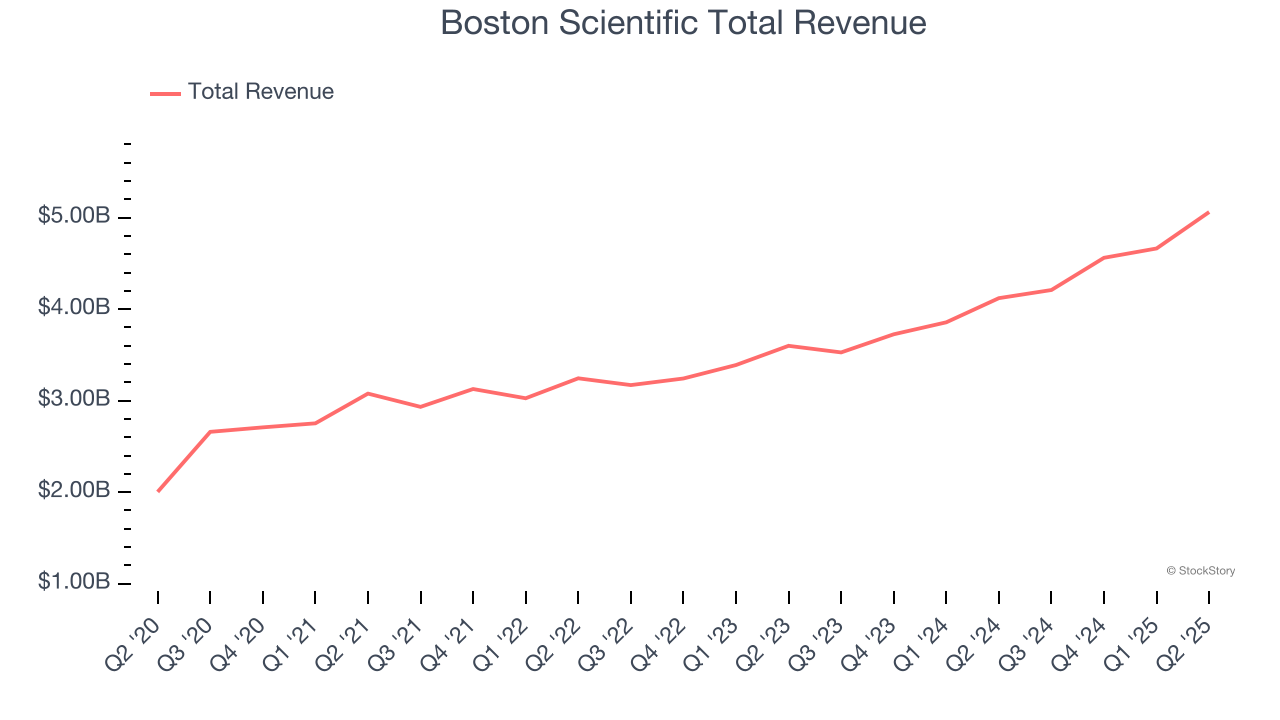
Earnings results often indicate what direction a company will take in the months ahead. With Q2 behind us, let’s have a look at Stryker (NYSE: SYK) and its peers.
The medical devices industry operates a business model that balances steady demand with significant investments in innovation and regulatory compliance. The industry benefits from recurring revenue streams tied to consumables, maintenance services, and incremental upgrades to the latest technologies. However, the capital-intensive nature of product development, coupled with lengthy regulatory pathways and the need for clinical validation, can weigh on profitability and timelines. In addition, there are constant pricing pressures from healthcare systems and insurers maximizing cost efficiency. Over the next several years, one tailwind is demographic–aging populations means rising chronic disease rates that drive greater demand for medical interventions and monitoring solutions. Advances in digital health, such as remote patient monitoring and smart devices, are also expected to unlock new demand by shortening upgrade cycles. On the other hand, the industry faces headwinds from pricing and reimbursement pressures as healthcare providers increasingly adopt value-based care models. Additionally, the integration of cybersecurity for connected devices adds further risk and complexity for device manufacturers.
The 6 medical devices & supplies - diversified stocks we track reported a mixed Q2. As a group, revenues beat analysts’ consensus estimates by 1.1% while next quarter’s revenue guidance was 1% below.
While some medical devices & supplies - diversified stocks have fared somewhat better than others, they have collectively declined. On average, share prices are down 2.6% since the latest earnings results.
Stryker (NYSE: SYK)
With over 150 million patients impacted annually through its innovative healthcare technologies, Stryker (NYSE: SYK) develops and manufactures advanced medical devices and equipment across orthopedics, surgical tools, neurotechnology, and patient care solutions.
Stryker reported revenues of $6.02 billion, up 11.1% year on year. This print exceeded analysts’ expectations by 1.6%. Overall, it was a strong quarter for the company with a solid beat of analysts’ organic revenue estimates and a narrow beat of analysts’ full-year EPS guidance estimates.
“We again delivered double-digit sales and adjusted earnings per share growth in the second quarter,” said Kevin A. Lobo, Chair and CEO.

The market was likely pricing in the results, and the stock is flat since reporting. It currently trades at $393.15.
Is now the time to buy Stryker? Access our full analysis of the earnings results here, it’s free.
Best Q2: Boston Scientific (NYSE: BSX)
Founded in 1979 with a mission to advance less-invasive medicine, Boston Scientific (NYSE: BSX) develops and manufactures medical devices used in minimally invasive procedures across cardiovascular, urological, neurological, and gastrointestinal specialties.
Boston Scientific reported revenues of $5.06 billion, up 22.8% year on year, outperforming analysts’ expectations by 3.4%. The business had a very strong quarter with a solid beat of analysts’ organic revenue estimates and a decent beat of analysts’ full-year EPS guidance estimates.

Boston Scientific scored the biggest analyst estimates beat and fastest revenue growth among its peers. The market seems content with the results as the stock is up 2.7% since reporting. It currently trades at $106.05.
Is now the time to buy Boston Scientific? Access our full analysis of the earnings results here, it’s free.
Weakest Q2: Baxter (NYSE: BAX)
With a history dating back to 1931 and products used in over 100 countries, Baxter International (NYSE: BAX) provides essential healthcare products including dialysis therapies, IV solutions, infusion systems, surgical products, and patient monitoring technologies to hospitals and clinics worldwide.
Baxter reported revenues of $2.81 billion, up 4.3% year on year, in line with analysts’ expectations. It was a softer quarter as it posted a significant miss of analysts’ EPS estimates and a miss of analysts’ full-year EPS guidance estimates.
Baxter delivered the weakest performance against analyst estimates in the group. As expected, the stock is down 12.6% since the results and currently trades at $24.53.
Read our full analysis of Baxter’s results here.
CooperCompanies (NASDAQ: COO)
With a history dating back to 1958 and a portfolio spanning two distinct healthcare segments, Cooper Companies (NASDAQ: COO) develops and manufactures medical devices focused on vision care through contact lenses and women's health including fertility products and services.
CooperCompanies reported revenues of $1.06 billion, up 5.7% year on year. This number was in line with analysts’ expectations. Taking a step back, it was a slower quarter as it logged a miss of analysts’ organic revenue estimates and full-year revenue guidance slightly missing analysts’ expectations.
CooperCompanies had the weakest full-year guidance update among its peers. The stock is down 12% since reporting and currently trades at $65.23.
Read our full, actionable report on CooperCompanies here, it’s free.
Abbott Laboratories (NYSE: ABT)
With roots dating back to 1888 when founder Dr. Wallace Abbott began producing precise, dosage-form medications, Abbott Laboratories (NYSE: ABT) develops and sells a diverse range of healthcare products including medical devices, diagnostics, nutrition products, and branded generic pharmaceuticals.
Abbott Laboratories reported revenues of $11.14 billion, up 7.4% year on year. This result surpassed analysts’ expectations by 0.9%. However, it was a slower quarter as it recorded organic revenue in line with analysts’ estimates and full-year EPS guidance in line with analysts’ estimates.
The stock is flat since reporting and currently trades at $131.61.
Read our full, actionable report on Abbott Laboratories here, it’s free.
Market Update
The Fed’s interest rate hikes throughout 2022 and 2023 have successfully cooled post-pandemic inflation, bringing it closer to the 2% target. Inflationary pressures have eased without tipping the economy into a recession, suggesting a soft landing. This stability, paired with recent rate cuts (0.5% in September 2024 and 0.25% in November 2024), fueled a strong year for the stock market in 2024. The markets surged further after Donald Trump’s presidential victory in November, with major indices reaching record highs in the days following the election. Still, questions remain about the direction of economic policy, as potential tariffs and corporate tax changes add uncertainty for 2025.
Want to invest in winners with rock-solid fundamentals? Check out our Top 6 Stocks and add them to your watchlist. These companies are poised for growth regardless of the political or macroeconomic climate.
StockStory is growing and hiring equity analyst and marketing roles. Are you a 0 to 1 builder passionate about the markets and AI? See the open roles here.




